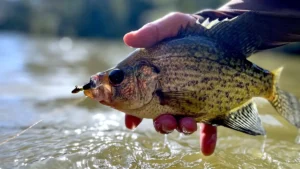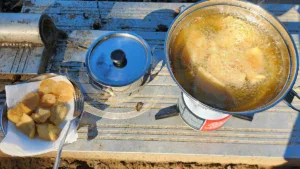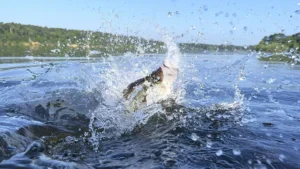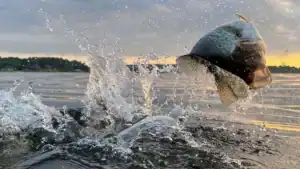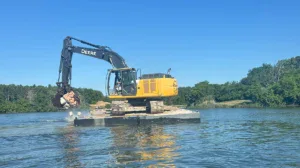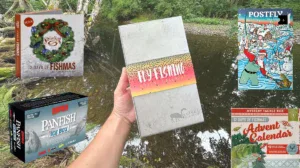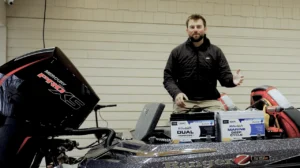Knowing how to catch crappie on riprap is a valuable skill that every angler should have at their disposal.
Crappie fishing takes on many forms across the country, from sitting on a bank anxiously watching a bobber above a minnow a few feet away, to pulling a variety of 3-inch crankbaits 150 feet behind the boat at 1.5 mph. Regardless of your preferred tactic, cover and structure dominate our approach, and one type of “structural” cover that can’t be overlooked is riprap. Fishing for crappie on riprap is one skill all crappie anglers should learn.
Riprap consists of granite, limestone, or concrete rubble in large chunks, essentially big rocks deposited along shorelines to guard against erosion. These rock ledges provide excellent cover for crappie to ambush prey and spawn, and when deep water parallels the riprap ledge, crappie will make use of this corridor throughout most of the year.
Professional crappie angler and television host of the Midwest Crappie Series, the B’n’M Anytime Crappie DVD’s, and his new show Brushpile Fishing which airs on FoxSports Ohio, Russ Bailey, has been plucking crappie from riprap for decades. Russ knows how to identify and effectively fish the variations that are present in nearly all riprap banks.
“Riprap provides everything a crappie needs from protection to forage,” Bailey said. “Current breaks, hard bottoms and variances in water temperature are all characteristics of riprap that attract crappie.”
DISSECTING RIPRAP
The best parts of a long, mundane stretch of seemingly identical rock bank may not be immediately obvious to anglers. Locating both the obvious points and the slightest alterations are the keys to pinpointing crappie on riprap. Hit the points
When riprap is in the form of a dyke or levee and utilized to protect a bay or shift current, big points are perfect for slab crappie.
“Points are my absolute favorite places to fish on riprap,” Bailey said. “A big point can offer every other quality you’d look for while fishing riprap, but all in the same place.”
Subtle nuances
“I look for any abnormality in the rock wall. A small protrusion or indentation above the water is generally consistent with what’s below the surface, and these areas regularly hold more crappie. A drainage pipe or culvert, even if it’s completely above the water’s surface, will likely indicate an indentation below.”
Cover within cover
Cover within cover is always a likely spot to find crappie, and riprap offers an abundance of these honey holes.
“If I see anything other than rock protruding from the water or on my graph, I’m going to try those areas,” Bailey said. “A ladder going down into the water or any wood that’s become lodged in the rock are ideal areas. Sometimes you’ll find sections of pea gravel, and these are hot spots as well, especially during the spawn.”
Effect on the water
Aside from moss and other vegetation covering the rocks that attract baitfish, the effect riprap has on the water surrounding may be the most important factor.
“In the Spring when the sun hits the rocks, the water warms up around them quicker, bringing crappie close to the surface,” Bailey said. “The afternoon bite is so good in early Spring because of the warmer water attracting bait. When there is current present, riprap will often provide breaks, and crappie will lay in wait in that still water.”
TACTICAL APPROACH
Casting a float
While there are a number of ways to fish riprap, Russ believes that the most effective tactic is casting a jig under a float.
“During the spring, I’ll fish a 1/32-ounce jighead with a Southern Pro 2-inch Stinger Shad, from 18 inches to 3 feet below a small pegged float,” he said. “Casting the float allows me to basically vertical jig with exact depth control without having to get too close and chance spooking fish. I’ll position my boat parallel to the riprap with the bow in the wind, and I will cast in front of the boat while easing forward with the trolling motor.”
Crappie will move up and down the riprap like a ladder, and during a cold front or in the fall or winter, they may be holding deeper on the rock ledge. The pegged cork allows for quick and easy depth adjustment when necessary, while letting me keep my bait in the strike zone longer.
Casting jigs
While casting jigs at riprap without a float takes a bit more talent and finesse, it can be effective during certain times.
“When the crappie are really aggressive, I’ll throw a bigger, Southern Pro Hot Grub and retrieve it just above the edges of the rocks,” Bailey said. “You have to be careful not to let the jig fall down between the rocks and get hung, and I’ll sometimes go to a lighter head to keep it from diving as much.”
Spider-rigging riprap
A less used but sometimes effective tactic on riprap is spider-rigging. With precise boat control, you can push multiple baits and various depths parallel to the rock ledge. Pushing into the wind allows for the most control, and with most riprap declining on a 45 degree or greater angle, an angler pushing multiple 14-foot poles can fish near the bottom in 1 foot of water on the inside pole and 12 feet on the outside!
CRAPPIE TACKLE CHOICES
Color of choice
“I prefer to let the water clarity and the fish dictate my jig color,” Bailey said. “In clear water, I’ll use natural and translucent colors, and in stained to muddy water, I’ll use solid, brighter colors. Popsicle, Pinky Shad, and Electric Chicken in the Southern Pro Stinger Shad are all good choices during the spring.”
Weapons of choice
While most anglers would employ a 6- to 7-foot spinning rod, most anglers don’t get the chance to design their own rod specifically for their favorite tactic. The B’n’M Russ Bailey Crappie Wizard is a 10-foot, 6-inch graphite rod with a cork handle and a stiffer action than most light rods.
“I like the longer rod; it allows me to cast the float farther and make subtle twitches to entice a crappie easier than a shorter rod,” Bailey said. “It’s also more effective at getting solid hooksets from longer distances.”
Bailey uses the B’n’M Pro Series spinning reel and 6-pound hi-vis Gamma line.
Knowing how to catch crappie on riprap will help you land more crappie throughout the year, and learning why and how riprap crappie move, and what other factors affect their pattern will provide you better all-around crappie fishing.






